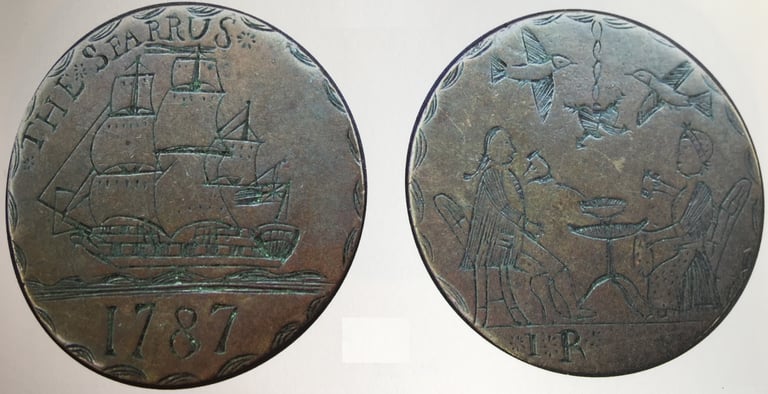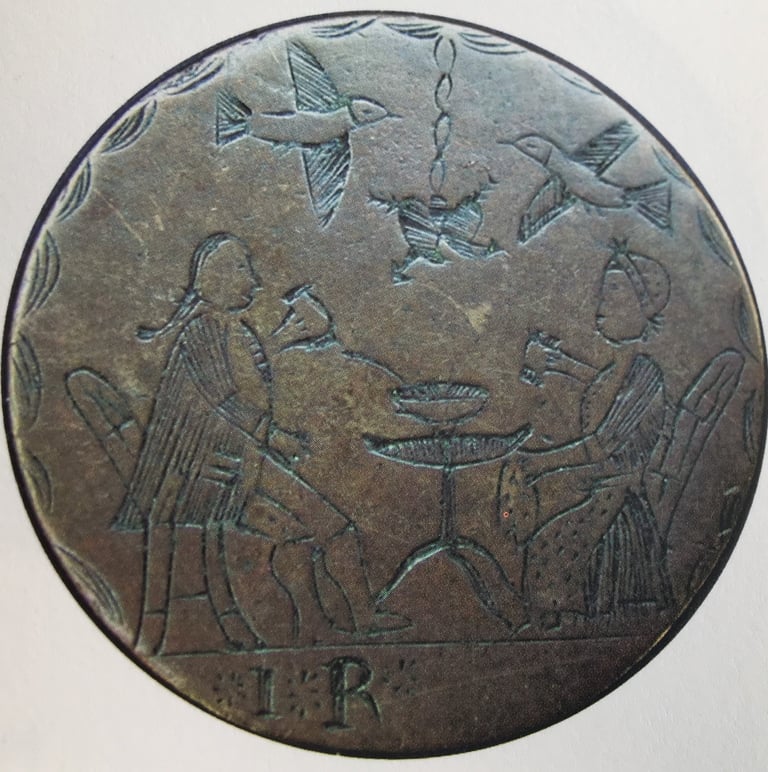A First Fleet Love Token?
A love token from a private collection for HMS Searrus and dated 1787 is probably an artefact from Australia's First Fleet, possibly given by one of the private marines to his love shortly before the fleet sailed.
Gary L. Sturgess
5/23/20253 min read
Throughout the 18th and 19th centuries, it was common for men and women going to sea to leave an engraved coin or medallion with a loved one as a token of their affection, although objects were also engraved in celebration of the voyage. Four such objects survive for Australia’s First Fleet:
· A silver fob engraved for the captain of the Borrowdale, Hobson Reed, with his initials on one side and an image of the ship and the words, ‘Success to the Borrowdale’ on the other. It is privately owned.
· A silver medallion for the Friendship, with an image of the ship engraved on one side, with the words ‘Success to the Friendship 1787’, and the letters ‘F.W.’ on the other, the initials of the master, Francis Walton. This is owned by the UK's National Maritime Museum.
· A silver medallion for the Charlotte with an image of the ship and the words ‘The Charlotte at anchor in Botany Bay Jan'y 20 1788’, and the reverse filled with text describing the voyage. This is owned by the Australian National Maritime Museum.
· A thin copper disk for the Charlotte, also in private hands, with engraved text on both sides describing the voyage, and four irregular perforations.
No love tokens are known to have survived, although it seems likely that a copper medallion for the voyage of HMS Searrus in 1787 is associated with the First Fleet. A polished copper disk, 30mm in diameter, it is also part of a private collection.
There was no British naval vessel named Searrus. One possibility is that it was the Ceres, although the only ship with that name was being used as a hulk in 1787, and is unlikely to have been the subject of a love token.
The only other one that comes close is the Sirius, the commodore for the First Fleet, which was given that name in October 1786, shortly after HMS Berwick was chosen for the expedition and renamed.
Sirius was an unfamiliar name and there were a number of different spellings at the time, the most common being ‘Syrius’, although she was sometimes identified at the time as the ‘Ceres’, even by individuals who sailed with the First Fleet.


The reverse of the medallion shows a man and woman drinking. It has been suggested they are drinking tea, but the man seems to be holding a tankard, and the container in front of them is a punchbowl rather than a teapot. Above them are inscribed two doves, and a heart pierced by Cupid’s arrow, suspended by a chain. Whatever the chain was meant to signify, it does not mean that one of the couple was a convict, since the Sirius did not carry prisoners. The man has his hair pulled back in a braid and he is wearing a jacket and breeches. Beneath his image are inscribed the letters ‘I.R.’ (or J.R., as we would write them today).
If this was the Sirius, then the most likely candidate for ‘J.R.’ is Joseph Radford, a private marine from the NSW detachment who sailed out on the Sirius, and did not join the ship until the 20th of April 1787, several weeks before the fleet sailed. Given the man’s dress and hairstyle, it is much less likely that this was one of the three able-bodied seamen on the Sirius with the initials 'J.R.' – John Robertson, John Rowley or James Russell.
The Searrus medallion featured in a several Australian exhibitions in 1998 – at the Hyde Park Barracks, the Western Australia Museum and the Tasmanian Museum and Art Gallery - and at the British Museum the following year, but it is deserving of closer attention than it has received.
________________
The Searrus medallion is listed in Sim Comfort, Forget Me Not: A Study of Naval and Maritime Engraved Coins and Plate, (1745 to 1918), London: Sim Comfort Associates, 2004, pp.96-99.


Reverse of the Searrus medallion
The Searrus Medallion, obverse and reverse
Contact us
Connect with us
Botany Baymen acknowledges the traditional custodians of country throughout Australia and respects their connection to land, water and community.
© Botany Baymen 2024. All rights reserved.
You may download, display, print and reproduce this content for your personal or non-commercial use but only in an unaltered form and with the copyright acknowledged.

